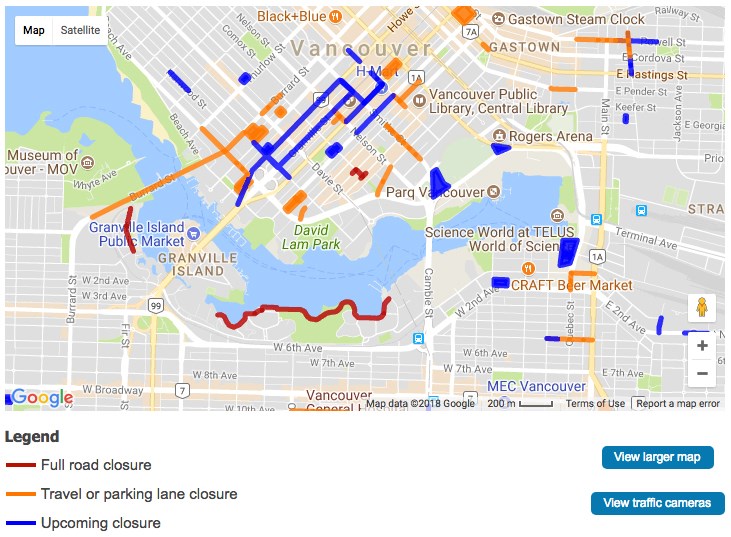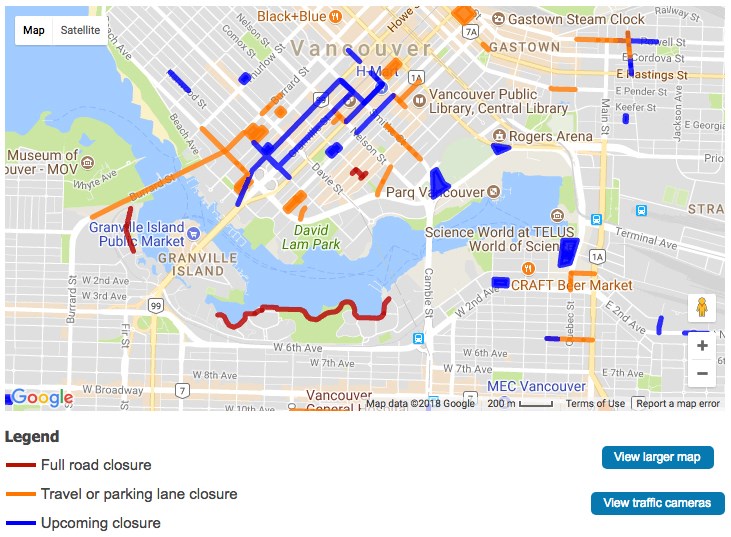A car trip through Vancouver can be frustrating at the best of times when you add road closures, streets can seem impassable.
In any given year, the city manages a range of sewer, water and street upgrades that have an impact on arterial streets, explained Devan Fitch, manager of project delivery for the City of Vancouver. Here are upcoming ones that are most likely to affect drivers:
- A project on Smithe Street between Homer and Beatty started in early January with a planned completion date of summer 2018. It involves upgrading critical sewer infrastructure to accommodate new developments downtown, resurfacing the roadway and making safety improvements to the bike network. There are local restrictions on turning movements but two lanes of traffic will be maintained at all times.
- Fraser Street from King Edward to 33rd Avenue: this project broke ground this week and will be completed in late summer 2018. The city will be maintaining one lane in each direction at all times. The work is for upgrades to water, sewer and streets infrastructure. “It’s a showcase for one of our better coordinated projects where we can get multiple disciplines in at the same time,” Fitch said. The city is also making some significant improvements to the sidewalks in the area for accessibility. People will mobility challenges or visual impairments will see some benefits.
- Work on Quebec and First Avenue starts in February with completion in late summer 2018. Traffic on Quebec Street will have one lane in each direction maintained at all times but there will be some limited closure of First Avenue in that area while construction is underway.
- Work in Oakridge is continuing in the 49th Avenue, West 46th Avenue and Tisdall area. It will continue until late summer 2018.
- St. Catherine’s sewer trunk work: It’s affecting East 39th Avenue, East 40th Avenue, Prince Albert Street and St. Catherine’s Street. There will be full street closures on some of the more local residential streets but laneway access will be maintained for residents.
Fitch said how much trouble the projects will cause depends on where people live, where they work and what routes they take.
“A small two-day project right in front of someone’s residence is probably more impactful than the arterial work on Smithe Street,” he said. “So it really depends on what they’re doing and how they get from A to B.”

The City of Vancouver outlines its road closure and construction projects on a map its website at vancouver.ca/roadwork. It features map identifying full road closures, travel or parking lane closures and upcoming closures. Fitch said drivers can use it to find out about traffic conditions and take steps to minimize the impact.
Planning for work and closures is complicated, according to Fitch, who calls it “a fine balancing act” that the city is getting better at every year.
“It’s one of the bigger challenges that we have,” he said, pointing out it’s not just city projects that get undertaken. There are also third-party projects or ones for B.C. Hydro, Metro Vancouver, Fortis BC or Telus, as well as closures caused by filming or special events and developer-driven projects.
“We have a team of dedicated staff in the city whose sole purpose is to have regular meetings with each of those different partner groups to plan out, to negotiate and to determine which projects can go we ahead with and which ones would we need to defer to a different year to minimize the overall impact to the network,” Fitch explained. “And, of course, we take a lot of steps to try and minimize the chance that we have a significant impact on two arterials next to each other.”
Fitch said the city does outreach before projects start and staff try to learn lessons from previous ones.
But plans are “rarely perfect.”
“When we implement, we certainly do encourage [input] and we do respond to feedback that we get, whether that’s from a commuter, a resident, a visitor to the city, Coast Mountain Bus Company or bus operators,” he said. “Where it makes sense, we make changes and make adjustments to minimize impacts.”
In terms of advice to drivers, Fitch said “information is powerful.” Aside from encouraging drivers to check the city’s roadworks map, as well as the city’s website for project-specific pages for major projects, he suggests those with smartphones download the city’s “VanConnect” app.
“Look at what the anticipated durations and areas of impact are and take steps that are available to minimize the interruption,” he said. “To some, that might mean a different time of day to travel and avoiding peak commuter times. For others, it’s a different route and for some it might mean taking a different mode, so if they can take transit, Canadaline or Skytrain, that might be helpful. The last resort is just to allow extra time for the journey and make sure they can make those appointments on time.”



